Modular LPDDR Memory Becomes A Reality: Samsung Introduces LPCAMM Memory Modules
by Ryan Smith on September 25, 2023 10:00 PM EST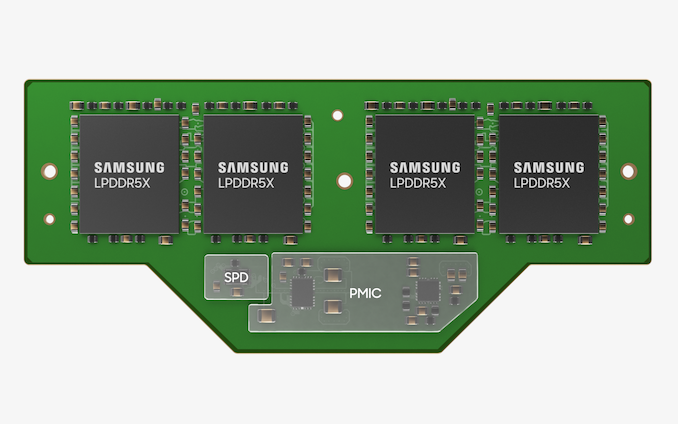
Although Low Power DDR(LPDDR) memory has played a pivotal role in reducing PC laptop power usage, the drawback to the mobile-focused memory has always been its tight signaling and power delivery requirements. Designed to be placed close to its host CPU in order to minimize power expenditures and maximize clockspeeds, LPDDR memory is unsuitable for use in traditional DIMMs and SO-DIMMs – instead requiring that it be soldered down on a device in advance. But it looks like the days of soldered-down LPDDR memory are soon at an end, as this evening Samsung is announcing a new standard for removable and modular LPDDR memory: LPCAMM.
Pitched as an LPDDR-centric version of the upcoming Compression Attached Memory Module (CAMM) standard for removable mobile memory, Low Power Compression Attached Memory Module (LPCAMM) is Samsung’s take on using the same style of compression connector interface for LPDDR memory. The net result is that, thanks to the more exacting specifications and shorter trace lengths used by a CAMM-style connector, Samsung says it’s possible to have modular and swappable LPDDR5 memory at last. And all in a fraction of the space a traditional SO-DIMM setup would occupy.
While the CAMM format has barely gotten off of the ground itself – JEDEC has yet to even approve the standard – Samsung is essentially opting to run with the idea to do something different with it by focusing on LPDDR memory. Notably, however, the resulting LPCAMM form factor is incompatible with CAMMs – both physically and electrically – so despite the similar names and use of compression connectors, the two are not interchangeable. But both pursue the same ideas for their respective memory types.
| Laptop Memory Module Standards | ||||
| AnandTech | LPCAMM | CAMM | SO-DIMM | Soldered |
| Memory Type | LPDDR5X | DDR5 | DDR5 | LPDDR5X |
| Max Official Data Rate | 7500 MT/s | 6400 MT/s? | 6400 MT/s | 8533 MT/s |
| Current Max Capacity | 128GB (Planned) | 128GB | 192GB (48GB x 4) |
32GB (per 64-bit bus) |
| Bus Width | 128-bit | 128-bit | 64-bit | Variable |
| Dimensions | 78mm x 23mm | ? | 67.6mm x 30mm | Variable |
LPCAMM is already in development at Samsung for a 2024 commercial release, and for this evening’s announcement Samsung sent over a render of an LPCAMM module. Which, combined with the company’s press release, provides a wealth of technical details on the new memory form factor.
The immediate takeaway is that with LPCAMM, Samsung is placing 4 x32 LPDDR5X memory packages directly over the compression connector, allowing for a 128-bit memory bus on a single memory module. While Samsung didn’t provide us with a picture/render of the opposite side, we’re told it’s basically all signal pads on the opposite side, similar to the connector portion of a full-size CAMM module.
Update 09/26: Samsung has since sent us over an additional set of diagrams of the pads, including the reverse side of the LPCAMM module. This illustrates very well the relationship between the positioning of the LPDDR5X memory modules and the signal pads below them.
Critically, because the LPDDR5X chips are directly over the connector, this minimizes the distance a signal travels between the host memory controller and memory chips. Even CAMMs, which reduced this distance, still required some distance for the signal to travel along the module from the connector to the memory chips farther away. In other words, Samsung has essentially created a socket form factor for LPDDR memory, with only the bare-minimum trance length and PCB between the chips and the motherboard.
The module itself measures 78mm x 23mm. Besides the DRAM packages themselves, the only other electronics on an LPCAMM module are the SPD, and the power management IC(PMIC). Which, like the CAMM standard, allows a module to provide for its own voltage regulation and identification. Since these components aren’t as sensitive to signal integrity and take up a decent bit of space themselves, they’re offset from the connector portion of the LPCAMM.
For their first generation of LPCAMM modules, Samsung is looking as capacities of 32GB, 64GB, and 128GB, with data rates up to LPDDR5X-7500. Samsung doesn’t currently have any 256Gbit LPDDR5X memory modules in their catalog, so either the company has a way to fit 8 modules on to an LPCAMM, or more likely they intend to introduce larger memory modules by the time LPCAMMs ship next year. Otherwise the data rate is a tier below Samsung’s best memory modules (8533 MT/sec), but I wouldn’t be surprised to eventually find out that it’s the trade-off for having modular LPDDR memory.
According to Samsung, they’ve already verified their LPCAMMs with an unnamed Intel platform – almost certainly Raptor Lake mobile, given the timing of the announcement. Though nothing about LPCAMMs is vendor-specific, and if the form factor is successful, I wouldn’t be surprised to see laptop manufacturers also pick it up for AMD designs.
Looking at the bigger (smaller?) picture, Samsung is pitching LPCAMMs as a crossover solution for offering a flexible amount of low-power memory in laptops, and perhaps more interestingly, servers. Currently system vendors wanting to install LPDDR have to solder the memory down at the time of manufacture, which means that there’s no further opportunity to adjust the amount of memory after the fact. So for modular memory, vendors (and customers) are stuck choosing between a fixed amount of LPDDR or a flexible amount of DDR on SO-DIMMs. LPCAMMs would be a middle-ground solution, allowing a flexible amount of faster LPDDR memory on a package smaller than SO-DIMMs (and with a lower total capacity), but still a bit larger than a compact and optimized soldered-down solution. The net result would be that system vendors could customize systems and install the appropriate amount of memory when the system is ordered, and laptop owners could swap in a larger LPCAMM farther down the line as a system upgrade.
The proposed use case for servers is quite similar as well. Servers are increasingly using LPDDR memory for improved performance and lower memory power requirements, such as with NVIDIA’s Grace platform. So a modular solution would allow server vendors to similarly configure systems at build time, and to do memory upgrades down the line without having to swap out the entire motherboard/system.
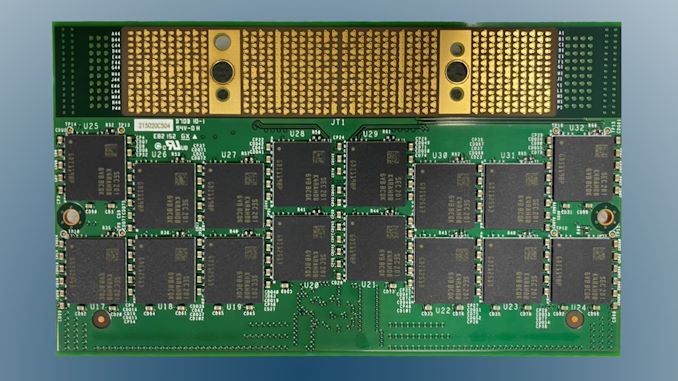
For comparison: the connector side of a pre-standardization Dell DDR5 CAMM module
For the moment, Samsung isn’t saying how LPCAMM compares to soldered LPDDR5X memory with regards to size or performance – it's bigger and likely a bit more power hungry due to trace lengths. Otherwise, as a replacement for SO-DIMMs, Samsung says that LPDDR5X LPCAMMs only occupy 40% of the space of a DDR5 SO-DIMM, and improve power efficiency by up to 70%, roughly in line with the general benefit of LPDDR5X over DDR5.
But even with this newfound flexibility, don’t expect to see LPCAMMs replace soldered LPDDR memory – at least not wholesale. Besides the higher qualified speeds for a soldered solution, LPCAMMs can’t match the smaller footprint of a soldered solution, especially as vendors are starting to put LPDDR memory directly on chip packages (i.e. Apple). Depending on the cost of implementation, LPCAMMs may displace soldered-on-motherboard memory, while ultraportable devices will increasingly embrace soldered-on-package memory to maximize space and efficiency.
As for standardization, according to Samsung they are working with partners to get a JEDEC standard for LPCAMMs. All the while, the JEDEC announced back in March that they were also working on extending the CAMM standard to cover LPDDR memory, using the same connector for both DDR5 and LPDDR5. At this time we’ve heard no further information from the group, and absent a ratified CAMM standard, it’s unclear if JEDEC is still moving forward with their LPDDR proposal. Ultimately, we may yet see rival CAMM-style standards for LPDDR memory, depending on how standardization shakes out.
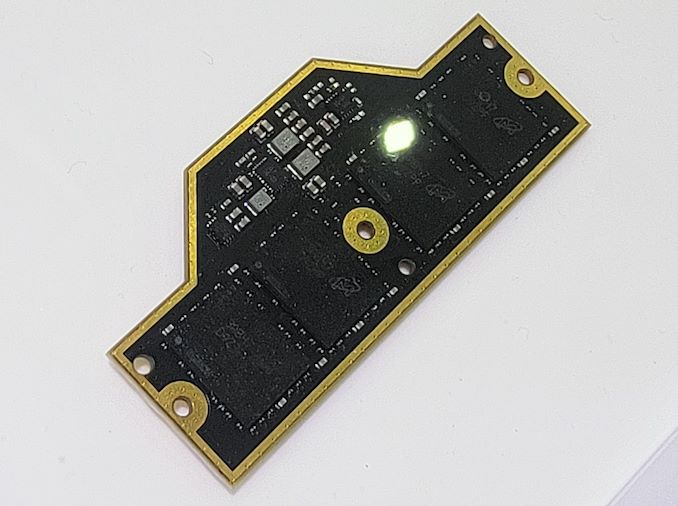
A suspicious compression attached memory module spotted at ADATA's Computex 2023 both in June
In any case, it looks like Samsung has already been working with at least one partner for several months. When scrolling through our archives, we spotted a picture of an LPCAMM module on the show floor of Computex 2023. Taken at ADATA’s booth, the module was labeled a CAMM, but is clearly in the LPCAMM form factor, giving us an idea of what a physical LPCAMM module looks like.
Wrapping things up, we expect to hear more about LPCAMM (and CAMM) in the coming months, especially as the later is finally standardized. If all goes according to plan, Samsung expects to be commercializing LPCAMMs in 2024, which should line it up to ship in systems based on Intel’s next-generation Meteor Lake platform.


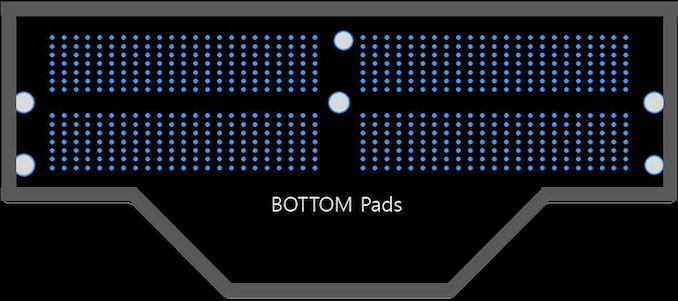
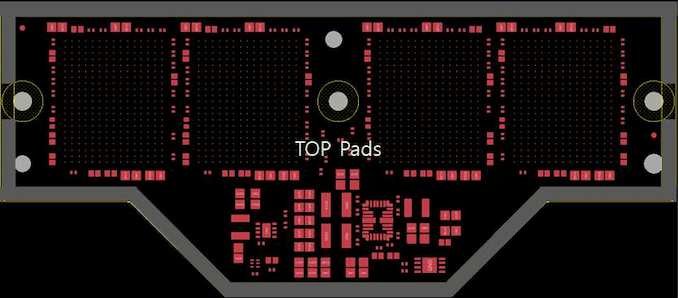








29 Comments
View All Comments
FWhitTrampoline - Thursday, September 28, 2023 - link
The CAMM memory module standard was started by Dell and I guess if Samsung is offering memory modules based on the IP then it's a JEDEC standard now! And any Standards body(JEDEC) adopting that IP as part of a JEDEC standard would require that Dell license that CAMM IP under FRAND(Fair, Reasonable and Non Discriminatory) licensing terms.So it's just like AMD's/SKHynix's HBM standard where JEDEC adopted that and standards body(JEDEC) adoption requires FRAND IP licensing to all the industry members in the DRAM Memory business. And Dell wants that because of economy of scale reasons and with all memory makers supplying CAMM based memory modules. And that's just good supply logistics economics there for more than one supplier of CAMM memory modules to Dell/Others and a cost competitive supply of CAMM memory modules for OEMs.
FWhitTrampoline - Thursday, September 28, 2023 - link
Can we get Laptops with LGA Packaged Processors, and Mini Desktop PC and AIOs as well, so that can reduce eWaste by allowing for processor replacement and upgrading by these devices end users.I'm all for a Very Hefty BGA Packaged Processor Tax(Or outright Regulations requiring Socket Packaged processors) to force Processor Makers and OEMs to offer Socket Packaged processors that are not BGA wedded to the device's Motherboard. There's an eWate issue with AMD not releasing any Ryzen 6000G or 7000G Desktop Socket Packaged APUs with the more powerful Integrated Graphics and Ditto for Intel's Meteor Lake processors that will only come in BGA packaging and not LGA Packaged Processor offerings.
So that LPCAMM memory is touted as being replaceable as opposed to soldered memory modules while both Intel and AMD are intentionally forcing their anti-DIY BGA only Packaged processors there where Consumers will be forced to discard working Motherboards if the BGA Packaged processor goes bad as BGA Processors are not really end user replaceable.
There are 2 popular Very Small Form Factor DIY system builds that rely on some semblance of yearly processor upgrade cadence for Socket Packaged processors where AMD has intentionally stopped releasing any Ryzen G series Desktop(Socket Packaged) processors(Ryzen 5000G series was the last of the Socket package APUs) for the DIY market and Intel as well with their Meteor Lake processors! And for InWin Chopin and ASRock Desk Mini lines of DIY friendly Mini Desktop PC Form Factor system builds that take Socket Packaged processors that can be replaced or upgraded by the DIY End users.
And I still own an HP Probook 4540S Business Grade Workhorse Laptop with a Socket Packaged Ivy Bridge Generation core i7 3632GM "Mobile" Processor that's replaceable and that laptop can be get a processor upgrade as well. So why all the Green-Washing from Intel and AMD but why are both Intel and AMD so BGA Processor/OEM only focused there when that's not exactly environmentally sound there as when a BGA Processor dies the entire MB has to get tossed as well as that's not easily end user fixable. I'm all for the EU requiring Socket Packaged processors to reduce eWaste in Mini Desktop PCs and in laptops.
Skeptical123 - Thursday, September 28, 2023 - link
It's a lot more complicated than from both the tech and legal side. And the inherent scope of such a regulation would make most contemporary complex regulatory issues look trivially simple by comparison.FWhitTrampoline - Friday, September 29, 2023 - link
No it's definitely not and the cost is about the same for the PCB like Processor Packaging Substrate(Fiberglass and Organic resin) the Processor Die gets attached to. So that's either LGA pads or BGA(pads with solder balls attached) and maybe slightly rearranged pin-outs.And the Legal side is environmental(eWaste reduction) as well Right To repair related. And Intel for generations has taken its "Mobile" Processors and made Socket packaged variants in the form of Intel T series processors at 35W for those HP/Dell and Lenovo Thin Client Mini Desktop PCs that actually had socket packaged "Mobile" processors so Corporate IT Departments could maintain/manage fleets of 10s of 1000s those units and repair by swapping in a new MB if the MB went bad or the processor if that was what went bad.
It's all about anti-DIY and there's money to be made in limiting consumer choices and money to be made selling more MBs/Processors that come BGA attached and with all that tossed if one component fails so the consumer has to purchase a brand new Mini Desktop PC or even laptop.
meacupla - Friday, September 29, 2023 - link
Clevo, Eurocom, and Origin PC have socketed CPU laptops. They are extra thick.If you want socketed mini-PC, that's what mITX is for.
As for socketed AIOs, the thicker ones tend to be socketed.
There is no such thing as a Ryzen 6000G, because 6000 was a mobile only part. 7000G is in the pipeline, my guess.
Valantar - Saturday, October 7, 2023 - link
This reads like a rather typically myopic, and unrealistic comment that unfortunately makes this kind of debate extremely difficult with its false dichotomies and oversimplified causality. Real shame.First off, AMD APUs have always launched later than their CPUs for any given platform, and AM5 APUs are coming. Stop making your impatience into a conspiracy - they've barely started arriving in laptops in volume, and laptops get the vast majority of APU chips.
Second, the strongest driver for BGA CPUs is thinner laptops, which customers really, really want. Very few people would be willing to accept the 5mm+ (likely more) thickness increase necessary to fit an LGA CPU socket+retention mechanism into a mainstream laptop. It's a shame for upgradeability, but then cpu upgrades on any given platform are rather useless anyhow - so unless you also mandated support for 3-4 generations of cpu in that laptop motherboard the best you'd get is a minor performance bump at the cost of more power, upgrading from something like a Ryzen 5 to 7 or 7 to a 9.
(Also, on a side note LGAs are poorly suited for mobile use as the sprung pins can move if the laptop is jostled. Hardly ideal if your sleeping laptop loses contact with the cpu if you put your bag down a bit too hard.)
There are theoretically possible solutions for socketed CPUs that are thinner than current LGA sockets, but they would be very expensive and difficult to implement due to mechanical concerns when connecting thousands of sensitive pins in a small area for a device that is moved around a lot even while turned on, has to endure massive heat flux, and more.
Honestly though, something like Framework's swappable motherboard concept is far more practically feasible than swappable CPUs in laptops today. Yes, it is more wasteful, but it also circumvents the need for years-long BIOS support, making upgrades more likely overall as they'll actually support the new chips.
I want to see a world where tech is used until it's worn out, and is then repaired and kept in use - where every gadget over time becomes a ship of These us-like thing. And to a large degree I think government regulation is a necessity for this, as for-profit companies (especially those operating in the US with fiduciary responsibilities towards shareholders) will otherwise prioritize profits over sustainability 100% of the time. But the solutions you're suggesting here are simplistic and unrealistic. We need new solutions that don't regress on the actual features that actual users want - such as thin and light laptops with all-day battery life - for things like this to have any chance at widespread success.
FWhitTrampoline - Thursday, September 28, 2023 - link
Edit: eWate to eWaste and core i7 3632GM to Core i7 3632QM.Byte - Thursday, October 5, 2023 - link
can't wait for apple to never use this!dicobalt - Friday, October 13, 2023 - link
I'm betting at some point we will see CAMM sockets directly on top of CPU packages.